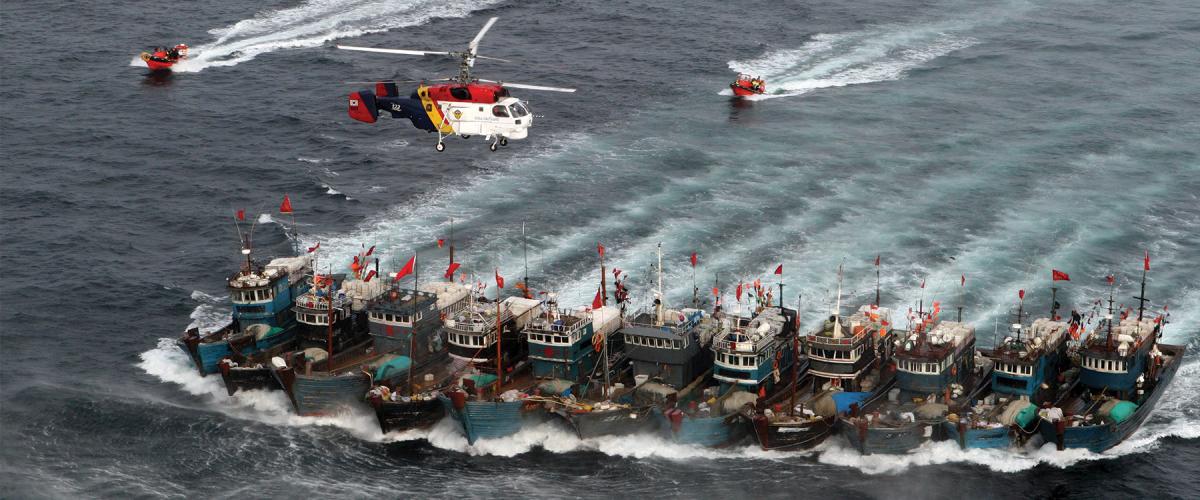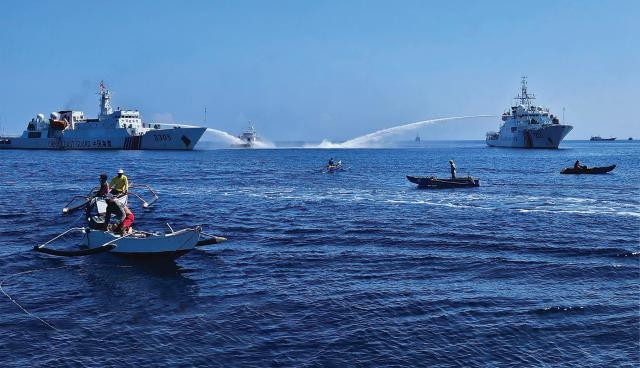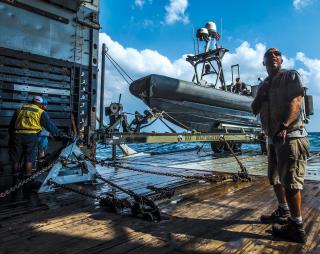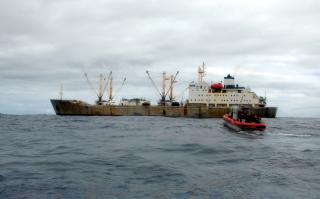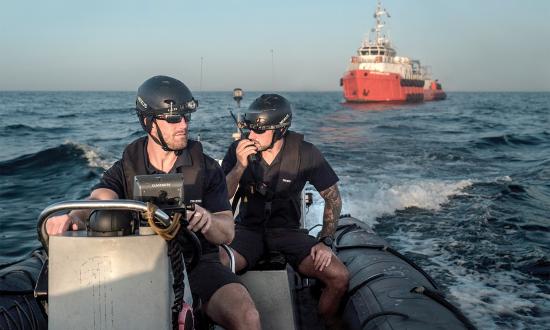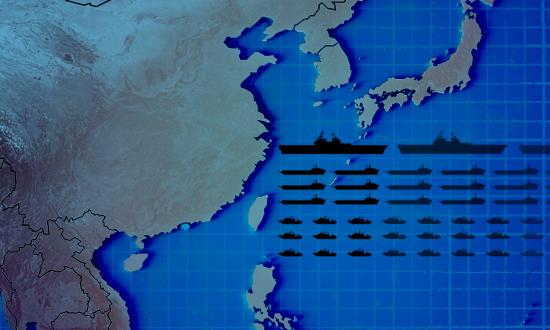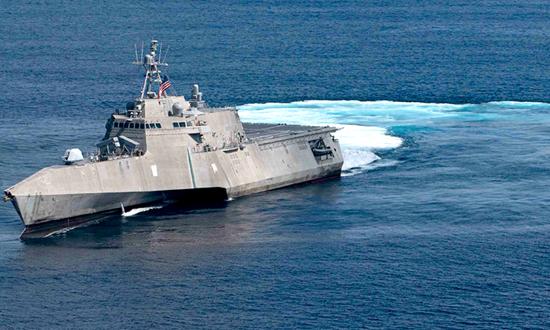Tensions in the South China Sea have been escalating for more than a decade, most recently in a series of clashes between China and the Philippines. A key player is China’s massive fishing fleet, which typically operates in a military gray zone adjacent to the China Coast Guard and not far over the horizon from the People’s Liberation Army Navy (PLAN). However, recent events suggest China is willing to be more open about the true nature of its People’s Armed Forces Maritime Militia (PAFMM).
Under international custom and law, these fishing vessels cannot be counted as warships, and yet they enjoy the sovereign immunity of their flag state, which is precisely the reason China has organized them—by some estimates, up to 200,000—into the PAFMM. Any action against a fishing vessel by a warship or merchant vessel of another state can be expected to be condemned by the Chinese government as hostile and unlawful, no matter how justified.
Considering China’s hegemonic ambitions, its maritime militia should be considered an auxiliary of the PLAN, and the United States and other nations should respond accordingly if the PAFMM continues to undermine the rules-based international order. In addition, the United States and its allies should consider invoking the right to issue letters of marque and reprisal if China insists on keeping the status of its “little blue men” vague.1 China has opened a new front in naval warfare, and the United States must counter this threat to the freedom of the seas.
What is a Warship?
The United Nations Convention on the Law of the Sea (UNCLOS) defines a warship as a “ship belonging to the armed forces of a State bearing the external marks distinguishing such ships of its nationality, under the command of an officer duly commissioned by the government of the State . . . and manned by a crew which is under regular armed forces discipline.”2 In addition, the United States asserts sovereign immunity for “other vessels owned by the United States, U.S. flagged bareboat and time-charter vessels, and voyage charter vessels for the duration of government service” in the same category as regular gray-hull naval auxiliaries—vessels carrying a USNS prefix and blue-and-yellow Military Sealift Command (MSC) stack markings.3 MSC does operate some unmarked auxiliaries—not painted haze gray as is commonplace for contemporary warships—but it is apparent the United States asserts sovereign immunity for these vessels, and flying U.S. colors satisfies UNCLOS’s “external markings” requirement.
The United States also has made common use of hybrid crews, combining civilian mariners (CivMars) with Navy service members, generally under operational command of a commissioned officer, raising two points for consideration in defining warships and auxiliaries:
• A warship need not be crewed solely by full-time, professional military sailors working for a regular armed force. Civilians who operate a navy vessel, even if they do not have a direct hand in the operation of weapon systems, are an integral component of the ship’s ability to carry out its mission.
• The operation of “civilianized” ships does not negate the overall control by the Navy, as opposed to some commercial or nonmilitary governmental entity. In fact, because a commissioned officer is the master of the vessel CivMars are sworn to obey, it stands to reason that a CivMar is under the regular discipline of a competent military authority.
Further, the lack of an officer on board a warship or auxiliary does not negate its status. The United States explicitly states: “U.S. Navy and U.S. Coast Guard vessels which, except for the lack of a commissioned officer as commanding officer would be warships, also are auxiliaries.”4 The U.S. military has a longstanding tradition of empowering noncommissioned officers to take independent, decisive leadership roles, and some Navy and Coast Guard boats do not carry commissioned officers, despite being armed vessels flying colors and conducting the operations of a warship. There is, however, always an officer in the chain of command above an individual boat unit. A reasonable interpretation of UNCLOS indicates that a vessel may be a warship or auxiliary if it is under the military command structure of a nation-state. Therefore, a boat launched from a warship with only seamen and noncommissioned officers on board is no less a sovereign vessel than the ship from which it launched.
Fishing Boats or Military Auxiliaries?
For the PAFMM, one consideration is whether a militia fishing vessel can be marked as a vessel enjoying sovereign immunity. Militia vessels carry Chinese flags and text names in Chinese script. Holding the PAFMM to the same standard by which the United States may judge other nations’ navies, the fleet meets the standard of a naval auxiliary in this regard.
The second factor is the degree to which the vessel is under the control of a commissioned officer. By the U.S. standard, the PAFMM’s level of integration and interoperability with the China Coast Guard and PLAN renders it likely there is an officer coordinating such efforts. In addition, China has, at least tacitly, admitted that a vessel operating under the PAFMM is doing so at the behest of state and military. In 2006, the Chinese government issued a white paper stating, “China’s militia is under the unified direction of the State Council and the [Central Military Commission], and the dual leadership of local Party committees and governments as well as the military commands.”5 That paper makes additional references to building up naval militia forces and better training and equipping them to operate as an integral part of the PLAN.
China also uses a concept called “people’s war,” which is most closely analogous to the World War II–era U.S. policies integrating all facets of the national economy with military objectives.6 China takes this a step further by using its regular armed forces to conduct civilian work and by training civilians to perform military tasks. This concept has been ingrained in the PAFMM since its formation in the late 1940s to prevent a reinvasion of mainland China by Kuomintang forces. Although the militia may not be in the regular service of the PLAN, it is China’s policy that “the principle of combining regular work with military training and combining peacetime needs with wartime needs are observed in the building of the militia.”7 The Chinese merchant marine fishing crews are regularly subjected to military training under this policy, which indicates they are under a form of military discipline sufficient to compel compliance and carry out orders.
Applying the standard to which the United States holds itself, a PAFMM vessel is a sovereign naval auxiliary of China when conducting any operation not directly related to fishing. However, the act of fishing as an instrument of state power can be reconsidered in a different light—one the United States has a unique ability to counter.
Privateering
Privateering is generally defined converting a privately held ship into a naval auxiliary and remunerating that vessel’s owners and crew with the profits from selling goods they capture. Although this practice was largely confined to Atlantic powers during the Age of Sail, reevaluating the actions of the PAFMM according to U.S. conventions invites comparison.
China’s “little blue men” are indisputably instruments of national power. Recent events combined with China’s position on militias are integral to the Chinese expansionist scheme, in much the same way as the British East India Company wielded military and political power on behalf of the British empire. Even before the firm was nationalized, Queen Elizabeth I “encouraged the development of this [privateer] supplementary navy” for the purpose of seizing Spanish treasure while remaining officially distant from the means taken to effect capture.8 In the case of the PAFMM, however, a key distinction is that there is no known prize court or compensation awarded directly to the fishing crews as a reward for capture.
If the PAFMM are just innocent fishing vessels co-opted by the government to its own end, China’s use of the PAFMM to expand its exclusive economic zone (EEZ) nevertheless benefits the militia by opening new fishing grounds from which they may profit. Should a PAFMM vessel prove to be little more than a PLAN ship dressed up as a fishing boat, the comparison to privateering is considerably stronger. Replace Spanish gold with the oil, mineral, and seafood resources inherent in a nation’s EEZ and the PAFMM is, by definition, privateering against rival nations. The fishing vessels “colonize” lands and strengthen the Chinese claims over those lands, thereby expanding China’s EEZ. They take direct action against the national vessels of other states and reinforce China’s circular claims of ownership by taking harvest from those waters, which could not be done legally unless those waters were already under lawful Chinese control.
Policy and Action
The United States and its friends and allies in the Indo-Pacific must adjust policy to reflect a better understanding of the PAFMM’s legal status. If it is determined the PAFMM are naval auxiliaries enjoying sovereign immunity, they cannot be interdicted on the high seas but may be ejected from the territorial sea of another nation should they breach innocent passage. Violations of innocent passage include not only any fishing activity, but also the “threat or use of force” against the sovereignty and territorial integrity of another nation, including aggressive maneuvers intended to intimidate or control the navigation of another nation’s warships or merchant marine.9 A strong, unified policy of ejecting PAFMM vessels, either under escort or by force, from seas internationally recognized as under the jurisdiction of other nations must be a cornerstone of regional agreements going forward.
Should China disavow the actions of its fishing fleet, they may be considered privateers, which are subject to interdiction if they carry out acts of piracy in the view of opposed governments. Law enforcement organizations would do well to conduct visit, board, search, and seizure operations against suspected PAFMM privateers, either forcing China to claim immunity (thereby exposing them to credible accusations of military actions against foreign nations without having declared war) or disrupting and discouraging illegal militia activity.
A holdover from antiquity presents another option: issuing letters of marque and reprisal. Although the maritime powers of 1856 outlawed the practice in the Paris Declaration of that year, the United States has consistently refused to ratify that treaty and retains that power in Congress under the Constitution. The most recently aggrieved nation in the South China Sea, the Philippines, does have a constitutional legislative power, similar to the U.S. War Powers Resolution, declaring that on “national emergency, the Congress may, by law, authorize the President, for a limited period and subject to such restrictions as it may prescribe, to exercise powers necessary and proper to carry out a declared national policy.”10 Should either country issues letters of marque reprisal (which must include prize courts to surrender captures to public ownership, if warships are so employed), China again would have to either claim immunity or tacitly admit the militia vessels were acting in a piratical fashion, undermining territorial claims based in part on their actions.
Prize courts would have to establish whether the militia vessel was a valid target for reprisal based on evidence of unwarranted and illegal aggression, with more immediate and tangible effects than existing admiralty courts. Letters of marque and reprisal should be narrowly targeted against specific offending vessels of the PAFMM. Warships or private vessels (in case of capture or retaliation as a means of defense by a merchant marine vessel) should be authorized to execute these letters, which would remove the guise of neutrality that has enabled the PAFMM to successfully carry out its mission. It also would reduce the PAFMM’s operational capability, no matter the immediate fallout and eventual outcome of this policy change.
1. Andrew S. Erickson and Conor M. Kennedy, “Beware of China’s ‘Little Blue Men’ in the South China Sea,” The National Interest, 15 September 2015.
2. “United Nations Convention on the Law of the Sea,” 10 December 1982, United Nations Treaty Series 397.
3. John Burgess, Lucia Foulkes, Philip Jones, Matt Merighi, Stephen Murray, and Jack Whitacre, eds, Law of the Sea: A Policy Primer (Medford, MA: The Fletcher School of Law and Diplomacy at Tufts University, 2017).
4. A. R. Thomas and James C. Duncan, eds., “Annotated Supplement to the Commanders Handbook on the Law of Naval Operations,” International Law Studies 73 (1999): 109–212.
5. People’s Republic of China Information Office of the State Council, China’s National Defense in 2006, 29 December 2006.
6. People’s Republic of China, China’s National Defense.
7. People’s Republic of China, China’s National Defense.
8. David M. Loades, The Making of the Elizabethan Navy, 1540–1590: From the Solent to the Armada (Martlesham, UK: Boydell & Brewer, 2009).
9. Thomas and Duncan, “Annotated Supplement to the Commanders Handbook.”
10. The Constitution of the Republic of the Philippines, article IV, section 23, part B.



